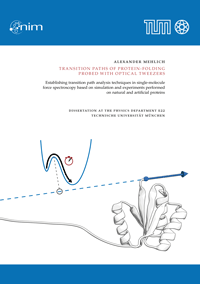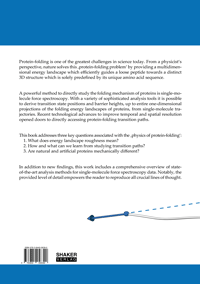
Shop : Details
Shop
Details
49,80 €ISBN 978-3-8440-5839-0Softcover296 pages77 figures777 g29,7 x 21 cmEnglishThesis
April 2018
Alexander Mehlich
Transition paths of protein-folding probed with optical tweezers
Establishing transition path analysis techniques in single-molecule force spectroscopy based on simulation and experiments performed on natural and artificial proteins
Protein-folding is one of the greatest challenges in science today. From a physicist‘s perspective, nature solves this ‚protein-folding problem‘ by providing a multidimensional energy landscape which efficiently guides a loose peptide towards a distinct 3D structure which is solely predefined by its unique amino acid sequence.
A powerful method to directly study the folding mechanism of proteins is single-molecule force spectroscopy. With a variety of sophisticated analysis tools it is possible to derive transition state positions and barrier heights, up to entire one-dimensional projections of the folding energy landscapes of proteins, from single-molecule trajectories. Recent technological advances to improve temporal and spatial resolution opened doors to directly accessing protein-folding transition paths.
This book addresses three key questions associated with the ‚physics of protein-folding‘:
1. What does energy landscape roughness mean?
2. How and what can we learn from studying transition paths?
3. Are natural and artificial proteins mechanically different?
In addition to new findings, this work includes a comprehensive overview of state-of-the-art analysis methods for single-molecule force spectroscopy data. Notably, the provided level of detail empowers the reader to reproduce all crucial lines of thought.
A powerful method to directly study the folding mechanism of proteins is single-molecule force spectroscopy. With a variety of sophisticated analysis tools it is possible to derive transition state positions and barrier heights, up to entire one-dimensional projections of the folding energy landscapes of proteins, from single-molecule trajectories. Recent technological advances to improve temporal and spatial resolution opened doors to directly accessing protein-folding transition paths.
This book addresses three key questions associated with the ‚physics of protein-folding‘:
1. What does energy landscape roughness mean?
2. How and what can we learn from studying transition paths?
3. Are natural and artificial proteins mechanically different?
In addition to new findings, this work includes a comprehensive overview of state-of-the-art analysis methods for single-molecule force spectroscopy data. Notably, the provided level of detail empowers the reader to reproduce all crucial lines of thought.
Keywords: transition paths; protein folding; single molecule mechanics; force spectroscopy; de novo protein design; energy landscape roughness; friction
Available online documents for this title
DOI 10.2370/9783844058390
You need Adobe Reader, to view these files. Here you will find a little help and information for downloading the PDF files.
Please note that the online documents cannot be printed or edited.
Please also see further information at: Help and Information.
Please also see further information at: Help and Information.
| Document |  | Document | ||
| Type |  | |||
| Costs |  | 37,35 € | ||
| Action |  | Purchase in obligation and download the file | ||
| Document |  | Table of contents | ||
| Type |  | |||
| Costs |  | free | ||
| Action |  | Download the file | ||
User settings for registered online customers (online documents)
You can change your address details here and access documents you have already ordered.
User
Not logged in
Export of bibliographic data
Shaker Verlag GmbH
Am Langen Graben 15a
52353 Düren
Germany
Am Langen Graben 15a
52353 Düren
Germany
Mon. - Thurs. 8:00 a.m. to 4:00 p.m.
Fri. 8:00 a.m. to 3:00 p.m.
Fri. 8:00 a.m. to 3:00 p.m.
Contact us. We will be happy to help you.



